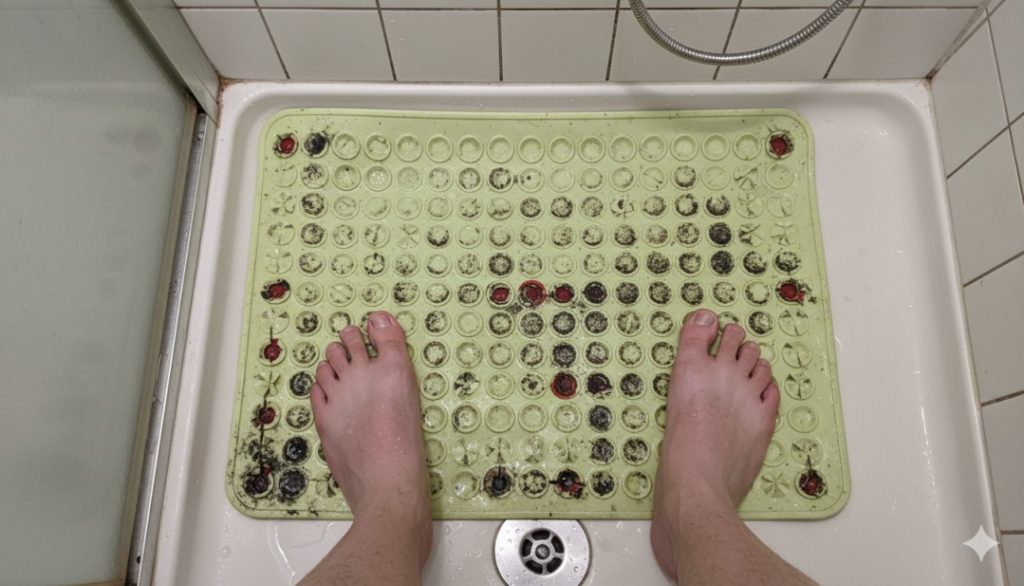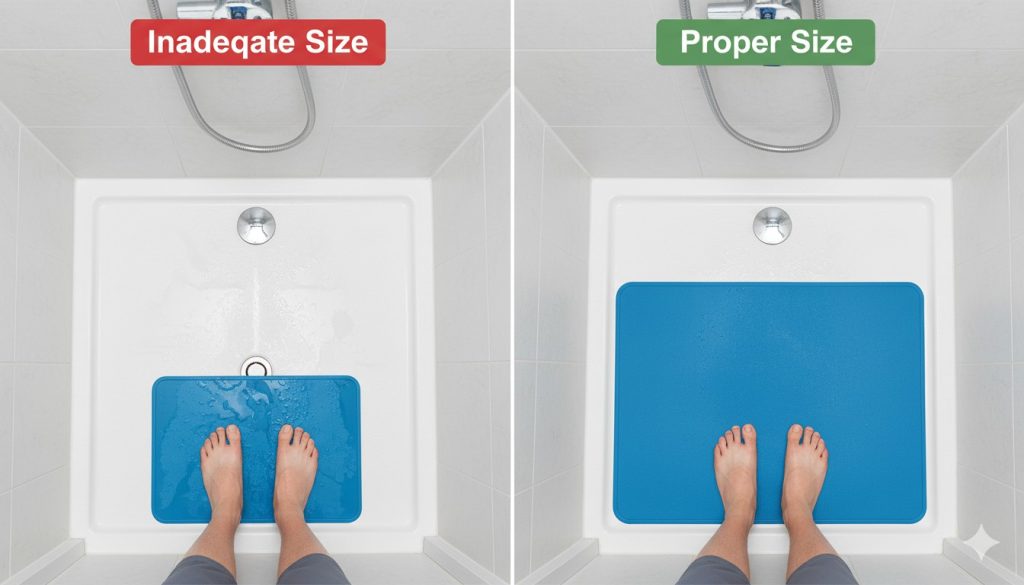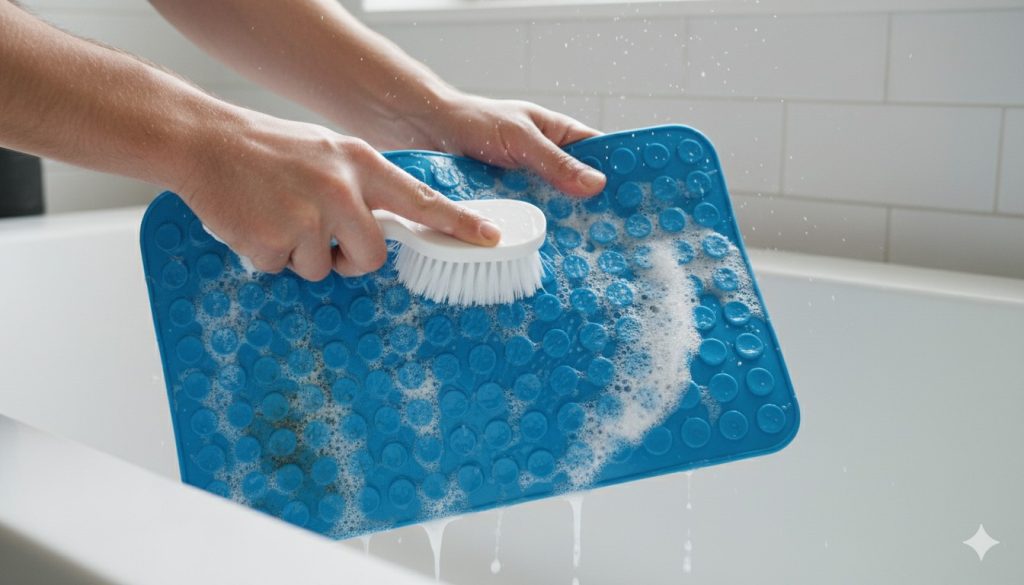I’ll be honest with you—I never thought much about my bath mat until I nearly ended up in the emergency room. One Saturday morning, I stepped into the shower like I had a thousand times before, and suddenly my feet went flying out from under me. I caught myself on the shower wall, but my heart was racing, and I realized I’d been making some seriously dangerous mistakes with something as simple as a bath mat.
That close call made me dive deep into bathroom safety, and what I discovered shocked me. Turns out, most of us are getting it wrong when it comes to our non-slip bath mats. So let me share what I’ve learned the hard way, because trust me, you don’t want to learn these lessons while you’re airborne in a wet shower.

The “Set It and Forget It” Trap
Here’s my biggest confession: I used the same bath mat for almost three years without replacing it. I know, I know—that sounds terrible now, but I honestly didn’t think it mattered. This is one of the most common bath mat mistakes that compromise your safety, and it’s something I see in friends’ bathrooms all the time.
Bath mats aren’t like towels that you can just keep washing indefinitely. They have a lifespan, and ignoring that fact is a recipe for disaster. After my near-fall, I flipped my mat over and was horrified. The suction cups had completely lost their shape, some were torn, and there was discoloration I didn’t even want to think about.
How Often Should You Actually Replace Your Bath Mat?
Most experts recommend replacing your non-slip bath mat every six months to a year, depending on usage. If you have a busy household with multiple showers daily, lean toward the six-month mark. Living alone and showering once a day? You might stretch it to a year, but honestly, after what I went through, I replace mine every eight months now, no exceptions.
The material breaks down over time, even if it looks fine on the surface. Those rubber suction cups lose their grip, the antimicrobial properties fade, and tiny tears in the material create perfect hiding spots for bacteria and mold.
Ignoring the Suction Cup Warning Signs
Let me tell you about bath mat suction problems—they’re sneakier than you’d think. Before my incident, I’d noticed my mat sliding around a bit, but I just pushed it back into place and went on with my shower. That was a massive non slip bath mat error on my part.

When suction cups start failing, your mat is essentially just a slippery piece of rubber sitting on an even more slippery surface. It’s not protecting you anymore—it’s actually creating a tripping hazard.
What I Check Now Before Every Shower
These days, I’m a bit obsessive about checking my mat, but can you blame me? Here’s what I look for: I press down on each section of the mat before I turn on the water. If I can easily lift an edge or if the mat shifts when I apply pressure, those suction cups aren’t doing their job. I also run my hand underneath to feel for soap scum buildup on the cups themselves—that stuff is like kryptonite for suction.
If more than a few suction cups feel flat or won’t stick properly, I clean them immediately. And if cleaning doesn’t fix the problem, that mat goes straight in the trash. It’s not worth the risk.
The Wrong Size for Your Space
This might sound obvious, but using the wrong size bath mat is one of those bathroom safety hazards that flies under the radar. I learned this when I moved from an apartment with a standard tub to a house with a larger walk-in shower.
I just brought my old mat with me because, well, why wouldn’t I? Except my old mat covered maybe half of the standing area in my new shower. I was literally playing a balance game every morning, trying to keep both feet on the mat while washing my hair. Looking back, it’s almost funny how oblivious I was to the danger.
Measuring Matters More Than You Think

Your bath mat should cover the entire area where you typically stand during your shower. For me, that means measuring from the drain outward to where I naturally stand when I’m under the showerhead. I now use a mat that’s at least 21 by 21 inches because I’m tall and tend to shift around while showering.
If you have a bathtub, the mat needs to run almost the full length. Skimping on size to save a few bucks is a false economy when you’re talking about preventing falls.
Placing It on the Wrong Surface
Here’s something I never considered until I started researching bathroom fall prevention: not all tub and shower surfaces work equally well with bath mats. Some of the common bath mat mistakes that compromise your safety stem from incompatible surfaces.
My old apartment had a textured tub bottom, and my mat gripped beautifully. My new house has a smooth, glossy shower pan, and that same type of mat was constantly sliding around. The surface texture makes a huge difference in how well those suction cups can grab hold.
The Surface Prep I Wish I’d Known About
The biggest revelation for me was that you need a completely clean, dry surface for initial placement. I used to just toss my mat in while the shower was already wet, which essentially guaranteed it wouldn’t stick properly. Now I place my mat when everything is bone dry, press down firmly on every suction cup, and do a pull test before I ever turn on the water.
For really smooth surfaces, I’ve learned that slightly dampening the suction cups themselves (not the shower floor) can actually help them create a better seal. It sounds counterintuitive, but that thin layer of water fills in microscopic gaps and improves suction.
Neglecting Regular Deep Cleaning
I used to think rinsing my bath mat after each shower was enough. Spoiler alert: it absolutely is not. This is one of those bath mat placement tips that goes hand in hand with maintenance—where you put your mat matters, but how you care for it matters just as much.
The soap scum, shampoo residue, and mineral deposits from your water all build up on both sides of the mat. On top, this creates a slippery film. On the bottom, it prevents the suction cups from gripping. It’s a lose-lose situation.
My Current Cleaning Routine
Every week, I take my mat out of the shower completely and scrub both sides with a mixture of white vinegar and dish soap. For the suction cups, I use an old toothbrush to really get into the grooves. Once a month, I soak the entire mat in a vinegar-water solution for about 30 minutes, then rinse thoroughly and let it air dry completely before putting it back.

I also make sure to hang it up or lay it flat to dry between uses when possible. Letting it stay crumpled or bunched up in the corner of the tub is just asking for mold and mildew to take hold, which weakens the material and creates another slipping hazard.
Using It Outside Its Intended Purpose
This might seem random, but hear me out. I used to pull my shower mat out and use it on the bathroom floor when my kids were little and bath time got messy. I thought I was being resourceful and preventing water damage to the floor. What I was actually doing was wearing out the suction cups faster and exposing the mat to different types of dirt and debris that could transfer back into the shower.
Non-slip bath mats are designed specifically for the wet, soapy environment of your tub or shower. Using them in other areas or for other purposes—like I’ve seen people do as knee pads while bathing pets—degrades their safety performance in the place where you need it most.
Overlooking Drainage Holes
Here’s a non slip bath mat error I made for way too long: I bought a mat without proper drainage holes because I thought the ones with holes would be less comfortable on my feet. What actually happened was that water pooled on top of the mat, creating a slippery surface that defeated the entire purpose of having a non-slip mat in the first place.
The standing water also meant my mat never fully dried between showers, which created a perfect breeding ground for mold and bacteria. I noticed a musty smell in my bathroom and couldn’t figure out where it was coming from. Yep—it was my supposedly “comfortable” bath mat.
Why Drainage Is Non-Negotiable
Good drainage holes allow water to flow through to the drain instead of pooling around your feet. This keeps the surface texture of the mat in contact with your skin, which is what provides the grip. It also means the mat dries faster, preventing that gross buildup that can compromise both hygiene and safety.
Now I only buy mats with adequate drainage holes, and I’ve noticed a massive difference. My bathroom smells fresher, my mat lasts longer, and most importantly, I feel way more stable while showering.
Not Adjusting for Different Users
This is something I didn’t think about until my elderly mother came to visit for a few weeks. What worked for my safety needs wasn’t necessarily enough for hers. Bathroom fall prevention becomes even more critical when you have family members or guests with different mobility levels or balance issues.
I ended up buying a second mat with extra texture and more suction cups for when she visited. It was a bit of extra effort, but knowing she was safer in the shower gave me incredible peace of mind.
Considering Everyone Who Uses Your Bathroom
If you have kids, elderly relatives, or anyone with mobility challenges using your shower, you need to think beyond your own needs. Some people benefit from longer mats that extend further, while others need mats with extra cushioning to reduce fatigue during longer showers.
I keep my standard mat for daily use, but I’m not too proud to swap it out when someone who needs extra support is visiting. Knowing how to use bath mat correctly means adapting to the situation, not just installing one and calling it done.
The Bottom Line on Bath Mat Safety
Looking back at all these common bath mat mistakes that compromise your safety, I’m honestly amazed I didn’t hurt myself sooner. These aren’t dramatic, obvious errors—they’re small oversights that pile up until you find yourself in a genuinely dangerous situation.
The bathroom is one of the most hazardous rooms in your home, and a good non-slip bath mat is your first line of defense against falls. But only if you’re using it correctly, maintaining it properly, and replacing it when needed.
Since I’ve fixed these bath mat safety mistakes in my own home, I genuinely feel more confident every time I step into the shower. I’m not subconsciously tensing up or moving cautiously anymore. I know my mat is doing its job because I’m doing mine—taking care of it and respecting the role it plays in keeping me safe.
Trust me, a few extra minutes of maintenance and a little vigilance are so much better than learning these lessons the hard way. Your future self will thank you for getting these bath mat placement tips right before something goes wrong.
Leave a Reply